Aria, 27, first noticed her hair falling out after she had Covid in 2021. “It started receding at the temples,” she says, adding that, after two further bouts of Covid, the hair on the side of her head is now fluffy and sparse. A part-time nanny studying for a master’s in speech therapy, she hides the problem with a fringe. When she goes out, she wears a cap or headband to anchor it down, but activities such as walking in the wind or swimming feel impossible. “Even a fringe is not protective enough because at any minute someone could flick it up,” she says. “It makes me feel so vulnerable.”
Aria started watching YouTube and TikTok videos of hair transplants two years ago. Now she has decided to take the plunge herself, and in a few days’ time she will check into at a clinic in Portsmouth, Hampshire, for a procedure that will cost £5,500.
Hair transplants have been available since 1952, when the dermatologist Norman Orentreich performed the first one, in New York. In 2022, more than 735,000 men worldwide had the procedure, many encouraged by celebrities including footballer and manager Wayne Rooney and actor James Nesbitt openly discussing their experiences. Turkey has become a global hub for hair transplants, due to its lower costs. Some even refer to the national airline as “Turkish Hairlines” as so many men, particularly from the UK, return from Turkey with bandaged heads after receiving hair transplants.
Now more women are having them, too – a global increase of 16.5% between 2021 and 2024, according to the International Society of Hair Restoration Surgery. It is still a male-dominated field – men account for 87% of the market – but the focus is shifting. Transplant surgeon Dr Edward Maitland Ball operated on one woman (and 83 men) in 2016, the year he founded the Maitland Clinic in Portsmouth; last year, 15 women (and 148 men).
But hair loss has troubling resonances for women, and going public about a transplant is rare for a woman. “Women are supposed to be so many things. Thin, but fertile. Successful, but homemakers. And hair is not something women are supposed to lose,” one woman who underwent a transplant tells me. This, then, is a story about hair loss and femininity, of bald spots and shame, and why, among younger women in particular, hair transplants are on the rise. Ultimately, it’s a tale not only about the behaviour of women, but also about the standards and values imposed on them.
About eight million women in the UK experience hair loss at some time in their lives. In men, it usually begins above the temples, the receding hairline eventually forming a characteristic M shape. Hair at the top of the head also thins. Women, on the other hand, will generally retain the hairline and thin out behind it. “It’s more of an overall, diffuse volume reduction,” says consultant trichologist Anabel Kingsley.
There are three typical stages in female pattern hair loss. Stage one is thinning at the crown and central parting, leaving a forest of hair on either side. By stage two, the hair is in retreat from the centre, exposing the scalp in what’s known as a “Christmas tree pattern”. By stage three, large areas on top of the head will be hairless. Even so, Kingsley says, “there are huge variations. Some women can have more of a male pattern loss; in others it is more noticeable around the temples. It’s much more complicated than with men.”
Baldness in men is triggered by the release of testosterone, which reacts with an enzyme in the blood to shut certain follicles off rather than turning them on. This leads to hair thinning and falling out. Male pattern baldness is at least 80% heritable. “We used to call hair loss in men and women androgenic alopecia,” Kingsley says, “which basically means it is genetic and due to the presence of androgens – male hormones. But now it’s thought that, in some women, testosterone doesn’t play a role. We call it ‘female pattern hair loss’ because the causes are not understood.”
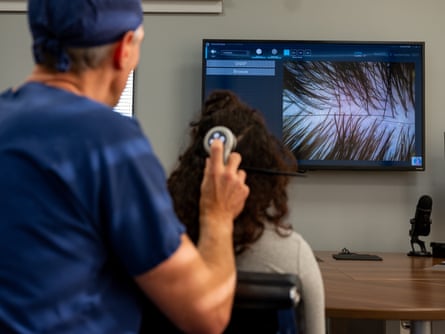
Historically, clinical drug trials have been done on middle-aged white men, she says, “so it’s no surprise more research is dedicated to male pattern balding, even though hair loss is both a male and female issue”. And the causes, for women, are many. Menopause (many postmenopausal women suffer hair thinning or bald spots); pregnancy; iron deficiency from periods; side-effects of the pill; crash dieting and restrictive eating; and medical conditions such as polycystic ovary syndrome can all affect hair growth. Even hairstyles can play a role. Gymnasts and ballet dancers who wear tight buns or ponytails are at risk of traction alopecia, a type of hair loss that occurs when tension damages or inflames the follicles.
And yet we are surrounded by images of women with artificially bolstered hair. A current trend on the red carpet, on Instagram and TikTok is “long, voluminous, abundant, shiny hair,” says Josh Wood, owner of an eponymous upmarket salon in west London and vice-chair of the British Beauty Council. The “power mane” – sported by the women of Trump world – signifies youth and fertility. It’s a style that might look free and easy, but achieving it is anything but, especially with older hair. “It looks like nothing’s been done, when you’ve virtually had the construction workers in,” Wood says.
Harriet, 69, a retired teaching assistant from Devon, who is married with three children, first noticed her hair thinning at her temples in her late 50s. “At first, you lie to yourself. You say, ‘I think it’s OK.’ Then after a while, because it’s a slow process, you think, ‘No, it’s definitely thinning.’ I could see the hairline gradually moving back.
My husband would say, ‘Oh, it doesn’t matter.’ But it’s how you feel and I was very self-conscious about it. If it was windy, I avoided going out or wore hats.” If she went swimming, she’d try not to get her hair wet. If she was out with friends, she’d sit with her back to the light: “You don’t want the light shining on the front of you as they might notice.” She’d brush her hair forward, lock it in place with hairspray and constantly check her reflection in shop windows as she walked by. “It’s horrible,” she says. “It niggles and niggles.”
Rogaine, the growth stimulant, helped. But it isn’t recommended for use after 65, “so I stopped. Then it started to get noticeably worse. I thought, is this just a part of getting older; can I accept it, like I accept having lines on my face? But this was worse, somehow.”
Harriet decided she had to do something. “I went online and looked at where all the footballers had their transplants done.” But the thought of the long drive from a London clinic back to Devon with a bloody head was too awful to contemplate. Instead, she turned to Ball’s clinic in Portsmouth. He checked if she had enough hair in the donor area at the back of her scalp. She asked him, “Won’t the transplanted hair fall out at my temples, too?” He reassured her that, as the DNA of the transplanted hair was different, it would stay.
A hair transplant costs between £3,000 and £10,000, depending on the number of grafts needed and the quality of the clinic. There are two techniques. Strip Follicular Unit Transplantation (FUT) is where a thin strip of skin is sliced from the back of the scalp, then dissected under microscopes into individual follicular units, or grafts, which are inserted into tiny incisions in the head. One of the main advantages for women is you don’t need to cut your hair for the procedure, which makes getting back to normal life a lot easier. The disadvantage is a scar where the strip was taken.
Alternatively, Follicular Unit Extraction uses a small device to punch out individual hairs from the back or side of the head, one by one. The main disadvantage is that the “donor area” must be shaved down to the skin. On the other hand, there is no scar.
Harriet had FUT and, two years on, she is thrilled. It looks perfectly natural, she says. It’s impossible to say where the original hair ends and the transplanted hair begins. “In terms of confidence and how much happier I feel about myself, it’s huge,” she says. But, apart from her husband, children and hairdresser, no one knows she’s had it done. “It’s personal,” she says. “It’s taboo.”
Perhaps surprisingly, it is no longer just women with extensive hair loss who are having transplants. Dr Roshan Vara, a hair transplant surgeon and co-founder of The Treatment Rooms in London, says his clients fall into two broad camps: women who are peri- or postmenopausal and have hair loss related to hormonal changes, and young women who aren’t losing their hair, but want to correct a hairline they don’t like.
High foreheads are not a beauty ideal trending on social media, he says. Instead there are memes mocking the singer Rihanna’s “fivehead”. Pinterest has 30 hair styles to hide big foreheads “so you never have to hear lame jokes or snide remarks again”. On TikTok, viewers are invited to watch “a hilarious video” of actor Dakota Johnson and others showing off their “big foreheads”.
Another undesirable beauty standard peddled to young women on social media is a “masculine” hairline with deep temples. Never mind that hairlines are neither “masculine or feminine”, Kingsley says. “It’s just societal pressure; another way to make us feel a bit crap about ourselves.”
Wood has noticed this greater focus on hairlines. “Women are on screen, pulling their hair back, wearing it in high ponytails, conscious of how the hairline frames the face.” Moreover, as cosmetic surgery and tweaks reset our standards of beauty, a natural hairline can start to appear an anomaly. “It doesn’t look right,” he says. Where once we were obsessed with straight teeth, he suggests, now it’s the “perfect hairline”.
Aria wants surgery to fix her hairline, not just hair loss. The average size of a woman’s forehead is 4.5-5.5cm, measured from between the eyebrows. Aria’s is nearer 7.5cm. She wants her hairline lower, “rounder”.
Aria lives in London with her parents, twin brother and an older sister who has, she says, an even higher forehead. “Some family members have said they could land a plane on her forehead. But she doesn’t care. She rocks it! She has a buzz cut! I love her for that.”
Yet the idea has lodged in Aria’s mind that her forehead is a problem to be fixed. It started as a low hum 10 years ago, and has grown. “Every time I step outside, the first thing on my mind is my forehead,” she says.
On holiday with a friend in Croatia, Aria marvelled at all the “beautiful things to do”. But each opened up a seam of worry. She refused to go snorkelling, but agreed to kayaking: “I wore a cap and said it was hot.”
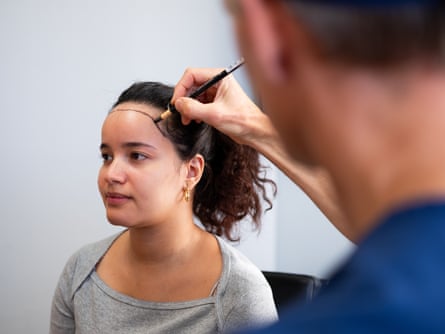
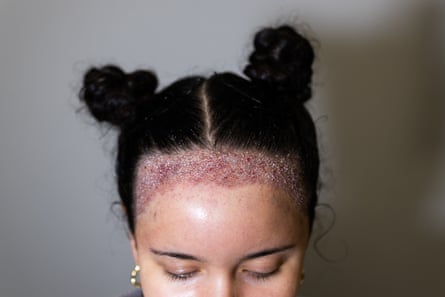
Aria has started dating a man in his late 20s. When they went on a mini-break, he wanted to ride a bike. She said no: she was worried the wind would blow, exposing her bare forehead. “And that was too anxiety inducing.” That night, he tried to stroke her hair. She jumped up, saying she needed to pee. “I had to make an excuse to get out of that situation,” she says now. It has begun to obsess her: “When I’m in lectures, I’m not paying attention, I’m looking at my fringe. I’ve got a mirror in the back of my phone, that’s the depth of my insecurity.”
Aria is “excited” about the hair transplant, but her father believes it is a terrible idea and could be a slippery slope to other surgeries. “I asked him: why is it OK for a man to get a hair transplant to feel better? He couldn’t answer me. We are currently not on speaking terms.”
Aria hasn’t told the man she’s dating, even though he has had a hair transplant himself. “He knows I’m having surgery next week,” she says, “but he thinks it’s for a gynaecological problem.”
On the morning of Aria’s transplant, she arrives at the Maitland Clinic at around 8am. A friend from university is with her. They got the train from London the day before and are staying in an Airbnb in the centre of Portsmouth for a week, in anticipation of a difficult recovery. “I’m very prone to swelling,” Aria says.
She had a consultation with Ball the night before. One of the things bothering Aria was the position of the new hairline. It was still too high. “Do you think Dr Ball will agree to lower it?” she’d asked when we first met.
When she came back to the Airbnb that night, the situation had been resolved. The central part of the hairline would come down by another half inch. The cost had gone up: £8.9k for 1,500 grafts. Aria went into the bathroom, looked in the mirror and burst into tears. It suddenly became clear her old self was about to go. “I was grieving my childhood features,” she says later.
The Maitland Clinic is situated on the second floor of an unremarkable building in Lakeside North Harbour, a short drive from the centre of Portsmouth. Formerly IBM’s national headquarters, it is now a business park of four-storey office buildings arranged around a lawn, with a cafe and 30,000 car parking spaces. It is a banal location, and that’s the point, Ball says: it’s discreet.
after newsletter promotion
Ball is 49, tall, tanned and fit. He swims and sails, and often cycles the 40 minutes to work from his home in a small village on Chichester harbour, where he lives with his wife, a GP, and their two children. A former GP and plastic surgeon, he trained with hair transplant pioneer Dr Craig Ziering in his clinic in Beverly Hills, California. He still benefits from this connection: “If his celebrity patients don’t want to travel to the US, he sends them to me.” The transplant he had done by Ziering in 2011 has, he says, given him a valuable insight into the trauma of hair loss. Every patient has a psychological assessment to ensure they are mentally robust and, for him, planning and preparation are everything.
In the surgery room, Aria sits in what looks like a dentist’s chair. Her hair has been washed with medicated shampoo, then plaited and pinned into two “space buns”. Ball uses electric clippers to shave the back of her head. He injects her scalp with a mix of lidocaine and adrenaline to numb it. (He also injects bupivacaine afterwards, a longer acting anaesthetic.) She’s already been given two tablets of codeine, a sedative.
Ball takes a scalpel and draws it across the back of Aria’s head. Her skin is pulled taut. He cuts a strip about 1.2cm wide and 17cm long, which is dropped into a petri dish filled with Plasma-Lyte (a solution that resembles human plasma). Aria says she can hear a “crunching noise” in her head as her scalp is cut open. Ball stitches up the wound and dresses it with a bandage, then stands back to admire his work. “The dressing has to be absolutely beautiful and symmetrical,” he says. “If you put on an ugly dressing with a scrappy bit of tape, the patient will think your surgery is scrappy.”
Meanwhile, his hair technicians are busy dissecting the strip of scalp at a long counter. The first, eyes pressed to a microscope, cuts the strip into slices. The skin looks grey and muscular in the petri dish, like an anchovy fillet. The other three divide the slices into follicular units. Each is categorised according to the number of hairs sprouting out of it: one, two or three. These are then subdivided by thickness: finest for the front of the new hairline; coarser ones behind. Each unit has its own muscles, blood vessels, nerves and glands. The skill is to keep these intact, so the follicle can take root.
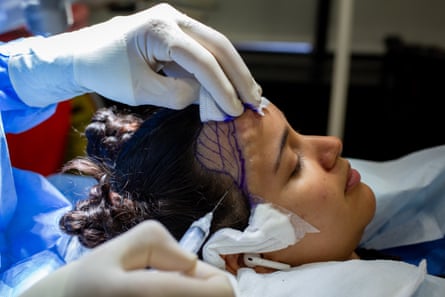
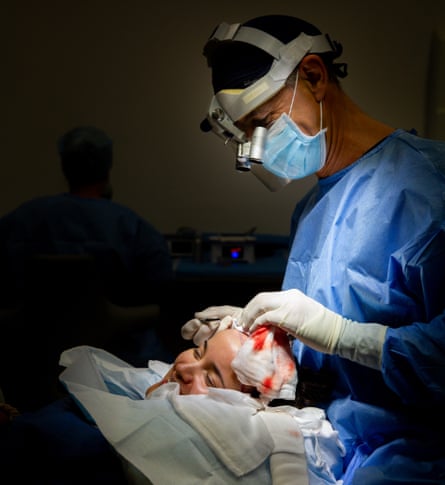
Aria, now relaxed from the codeine and anaesthesia, is watching Bridget Jones: The Edge of Reason on a large screen a few feet away from her. Transplants can take up to 12 hours, with patients awake the whole time, so there is an extensive choice of TV channels, crisps and chocolate bars. For lunch, Aria has a salmon poke bowl ordered from the cafe downstairs.
“Now for my favourite part – the arty bit!” Ball says. He takes a small blade with a sharp tip and repeatedly jabs it into the bare area of Aria’s new hairline, which he’s marked out with a black pencil. The best transplant surgeons copy nature with skilled incisions. Nearly horizontal slits for fine hairs at the brow that tend to jut forward. More vertical for hairs that stand up straight. The exact angle and direction varies with each slit to recreate the irregular wildness of a natural head of hair.
After Ball has made about 1,550 incisions – he keeps track with a digital foot counter – his transplant technicians take over. They take the grafts and “plant” each one into the tiny hole using fine forceps and an “implanter”, a pen-like instrument with a hollow needle for the graft at one end and a plunger on the other. The design, direction, angle and distribution of hair growth has already been determined by Ball. “It’s like painting by numbers,” hair technician Kate Shears says. “He’s doing the painting. We’re colouring in.”
Dr Vara is having an online consultation with Beatrice, a woman in her early 30s, who has inquired about a hair transplant. “Take me through what you’re worried about,” he says, to which she replies, “I want to see if you’re able to create a new hairline. Bring it down and maybe thicken it up a little bit.”
Beatrice has three children under 12. During her first two pregnancies her hair “flourished”, she tells Vara. “It was so thick and healthy.” She lost a noticeable amount after she gave birth – postpartum shedding is common, due to hormonal changes – “But my hair recovered.” After her last pregnancy, two years ago, however, her hair is “all over quite thin, thinner than it used to be. The overall density hasn’t returned.” It’s getting her down. Beatrice, who is of African-Caribbean heritage, has been wearing a wig to hide the problem.
She got the idea of having a hair transplant from her hairdresser, who had one in Turkey three years ago. “It looks amazing!” Beatrice says. Before that, she didn’t even know women could have them, and she became obsessed. It will cost around £5k, and she thinks it’s worth it. “It’s something I’ve struggled with for a long, long time and I think it would improve my confidence,” she tells Vara. She asks to book it in straight away, but Vara does not agree – not yet. He suggests Beatrice gets a blood test to check her thyroid function and iron levels, and recommends hair-growth stimulants, such as Rogaine. He asks if she can reduce her stress levels. As well as her three children, Beatrice has a full-time job in education. She is often harried and exhausted. Psycho-emotional stress can trigger and aggravate hair loss, and impede recovery after surgery. “A transplant needs optimal care and nutrition for three months. You may not have enough time for self-care,” Vara tells Beatrice. He suggests a review in six to nine months.
“Actually, out of the patients I see who are female, over 90% aren’t candidates for surgery straight away,” he says. Hair loss needs to have stabilised, otherwise, as the natural hair continues to recede, the plugs of transplanted hair are left exposed, surrounded by patches of bare scalp. The diffuse pattern of female hair loss can also make a transplant harder because of a limited amount of donor hairs to move to the new site. What’s more, “a lot of my female patients present with forms of hair loss that are relatively rare in men,” he says. For example, frontal fibrosing alopecia, a scarring condition that causes inflammation and destruction of hair follicles, leading to permanent loss, often at the hairline. “Conditions like these can’t be treated with surgery, certainly not in the initial stages,” he says, “though a lot of female patients do get treated in clinics that aren’t so experienced or reputable.”
“A lot of women are very distressed about hair loss and may think a transplant is a solution – as it is for most men. But for women, very often it’s not,” says Greg Williams, vice-president of the British Association of Hair Restoration Surgery (BAHRS). “Unfortunately, unscrupulous practitioners will take advantage of women and transplant when it’s not appropriate or necessary.
There is no accredited training for hair transplant surgeons in the UK,” he continues. “Basically, anyone can do it. It’s a wild west, both here and abroad.”
Rogue clinics will drive punches in at the wrong angle, so if hair grows at all, it’s in different directions, bedraggled and clumpy. Hairlines can be set too low, throwing out the natural balance of a face, and moving follicles a few at a time is labour intensive. “Some clinics unfortunately delegate surgical steps such as cutting skin to non-doctors – that’s why they’re cheap because a doctor may be supervising more than one surgery,” Williams says. BAHRS has launched #WhoMakesTheCut, a campaign to emphasise the steps only a doctor should do (it is acceptable for surgical assistants to place the hair grafts into the incisions the doctor has made).
Repairing transplant procedures now makes up 12% of Ball’s work, compared with 2% in 2019. “It’s becoming a problem,” he says. “People are desperate, and are told they can be fixed.” He puts me in touch with a woman, an actor whose voice is so well known I am allowed to communicate with her only by email, who he is seeing to repair a botched job on her hair.
The idea came from her aesthetic doctor. “He told me I needed it,” she writes, “that I could stop having Botox and filler as it would sort out the asymmetry of my face – ie my high forehead.”
He recommended a friend. She later discovered he was not experienced. “I was essentially a guinea pig.”
The procedure was done in a clinic in Harley Street. The doctor tried to record it on his phone while she was sedated. The room was “unsanitary”, she writes, “and the design and technique was terrible. Four or five hairs sprouting out of one follicle, then huge gaps.” He took a vast amount of follicles from the back of my skull – more than was needed, which will never grow back.”
Her skin became infected. Three years on, it’s still lumpy, red and scaly. The repair has cost over £20,000.
Women need to check the credentials of the surgeon, Ball says. Take time to do research and read patient reviews on forums such as hairlossexperiences.com or Reddit, and consult the BAHRS website. The doctor should carry out an unhurried and detailed consultation prior to surgery to establish the cause of hair loss and to properly understand goals and expectations. “Don’t rush into anything,” Williams says. “Consult a dermatologist or specialist first.”
A hair transplant, when it works, can feel life-changing. “Women are suffering in silence,” Ball says. “There’s not so much information out there for them. No celebrities are talking about it, no one is making them feel normal, so they feel ashamed. It takes away their feeling of femininity and they feel guilty about worrying about it, or beat themselves up for being vain. It’s not vanity!”
Still, they shouldn’t be the first port of call if you notice thinning. Kamila Hawthorne, chair of the Royal College of GPs Council, says in some circumstances it can be symptomatic of a more serious medical condition: “So if a patient is seeing an excessive amount of hair loss, they should seek support from their GP practice.”
If hair loss is affecting your mental health, the NHS offers advice on accepting the change and can point you towards support groups and cognitive behavioural therapy. “We recognise that hair loss can be distressing,” Hawthorne says, “but it is very normal for our hair to thin, especially as we age.”
It is nearly a week since Aria’s transplant and she’s already back home in London. In the end her father drove to Portsmouth to collect her two days after the surgery. “He is being super attentive, checking on me, bringing me drinks,” she says. “Apparently he said to Mum, ‘I can see why she had it done. She looks better.’ So they are both very on board with it now.”
She has a tight feeling around the scar in the back of her scalp and says she looked like a chipmunk for a few days: “My face was very puffy.” But she has finally told the guy she’s dating. “He said, ‘Why didn’t you tell me sooner? Now we’re hair transplant buddies!’ He says it looks cute, the little hairs sprouting through.”
Those transplanted hairs will probably fall out soon and the follicles become dormant. Then, after about three months, they’ll sprout again. She’ll have to wait a year or so to see what finally grows. “I wake up in the morning and I wash my face and I feel so elated, so happy,” she says. “I like what I see. Everything looks more in proportion. It just works.”
Some names have been changed.

 1 month ago
30
1 month ago
30

















































